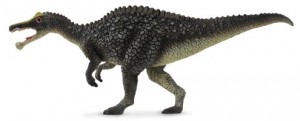A Black Coloured Model of Irritator – A Possible Explanation
The CollectA Irritator model, part of the company’s not to scale, prehistoric animal model range is coloured black. This is an intriguing colour choice for a dinosaur model, most dinosaur models from CollectA have been painted various shades of green or brown but black is not a colour often associated with such items, especially when it is hoped that these replicas would appeal to young dinosaur fans and model collectors. Could the plumage of an extant bird, found in Africa have influenced the design team?
CollectA Irritator Model
The CollectA Irritator Dinosaur Model
Picture credit: Everything Dinosaur
Fossils of this dinosaur are associated with the Santana Formation of eastern Brazil, the skull showed a number of anatomical features associated with spinosaurs and so Irritator was described as a member of the Spinosaurids. It is likely that this dinosaur, that may have reached lengths in excess of eight metres, was primarily a fish eater. Irritator was formally described in 1996 (Irritator challengeri).
But why did CollectA choose to give their Irritator dinosaur model a predominately black colour? The explanation put forward could have something to do with this dinosaur feeding mainly on fish. After all, the fossils ascribed to this genus of theropod dinosaur were found in brackish/marine deposits so it can be inferred that this large predator spent a lot of its time near bodies of water. This would tie in with the theory that this dinosaur was a hunter of fish.
Examining the Skull Material
When the skull material is examined it can be seen that the position of the nostrils are towards the top of the head and not at the very tip of the snout. The nostrils are not placed as far back on the skull as the nostrils of Spinosaurus (Spinosaurus aegyptiacus), but their position still suggests that Irritator could hold the tips of its jaws underwater and still breathe. This evidence along with many conical teeth associated with the Santana sediments suggest that Irritator was indeed a piscivore.
The Black Heron (Egretta ardesiaca), is a member of the heron family, it can be found in Africa, south of the Sudan and it is very common. It often can be seen feeding in the shallows of lakes, ponds and even in rice fields, where it catches fish and amphibians. As the name of this bird suggests, its plumage is black and one of its feeding techniques is to pull its wings forward to cast a shadow over the water. Fish are attracted to this shade and therefore come within reach of the sharp bill and are thus easier for the heron to catch. This feeding behaviour seen in Black Herons is often referred to as “Canopy Feeding”.
If Irritator had been black, or certainly dark coloured its outline above the water could have been more difficult for fish in the water to spot, especially against the backdrop of a densely vegetated bank. Perhaps Irritator held its arms out in front of its jaws producing an area of shade that potential prey may have been tempted to swim into. A black colouration, particularly across the top of the back of the animal would have enabled this creature to absorb heat from the sun very efficiently, little being reflected back off a light coloured more reflective surface. This may have helped this animal keep warm whilst standing in relatively cool water.
It is interesting to speculate on the choice of colour to the CollectA Irritator dinosaur model. In truth, there is no evidence to help scientists to establish what colour the dinosaur known as Irritator actually was.
To view the range of spinosaurid models and figures in the CollectA Prehistoric Life range available from Everything Dinosaur: CollectA Prehistoric Life Dinosaur Models.







Leave A Comment